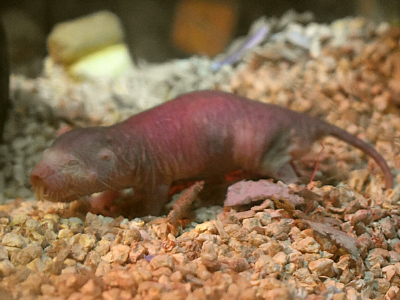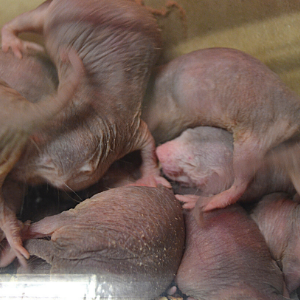Since late March, Komodo Kingdom has been closed to the public. Despite these animals being out of the public eye, the keepers have still been working to make sure they receive the best possible care. In that time, some of the animals have kept quite busy, especially our naked mole rats.
In late February, we welcomed our first litter of mole rat pups since the colony arrived roughly 3 years ago. In May, the queen gave birth to her second litter, followed by a third in late September. In the last 9 months, our colony has gone from 15 up to 40 mole rats of various sizes.
 As mammals go, naked mole rats are some of the strangest on the planet. Despite having “rat” in their name, they are actually more closely related to animals such as porcupines, chinchillas, or guinea pigs. Looking at them superficially, it is easy to see the similarities they share with other members of the rodent family. They have a set of very large incisor teeth, short legs, a skinny little tail, and even hair! If you look closely, you can see a few long white whisker-like hairs spread out over their body. These hairs are very sensitive to vibrations and are used to help the mole rats navigate their underground tunnels.
As mammals go, naked mole rats are some of the strangest on the planet. Despite having “rat” in their name, they are actually more closely related to animals such as porcupines, chinchillas, or guinea pigs. Looking at them superficially, it is easy to see the similarities they share with other members of the rodent family. They have a set of very large incisor teeth, short legs, a skinny little tail, and even hair! If you look closely, you can see a few long white whisker-like hairs spread out over their body. These hairs are very sensitive to vibrations and are used to help the mole rats navigate their underground tunnels.
Everything about them is built for living their entire lives underground. They have very tiny eyes and poor eyesight, instead relying on smells and vibrations to navigate their world. Their extra-large incisors are their primary tool used for digging tunnels. While digging, naked mole rats can even close their mouths with their teeth on the outside to prevent themselves from getting a mouthful of dirt. They then use their back feet to kick the loose dirt out of their way. Their tunnel system is specially designed for managing all of the colony's needs. They have certain chambers designated for different functions like food storage, nursery, and even a bathroom chamber.
Perhaps the most unique characteristic about the naked mole rats is their social dynamic. This species is one of the only truly eusocial mammals on the planet. This is most noticeable when observing how everyone in the colony helps to take care of the babies, much like a pride of lions watching their offspring while some members are out hunting. Even though the queen mole rat is the only female to have babies, the entire colony helps to take care of her offspring, even their older siblings. While the queen remains in the nest chamber with her young, the rest of the colony is in charge of bringing back food, cleaning, and even transporting the babies if necessary.
What separates the mole rats from other social mammals, like lions and meerkats, is that each member of the colony has a different job. For starters, you have the reproductive adults; only the queen and 1-3 males are capable of breeding, all the other members are workers. Imagine a colony of bees or ants with one queen who makes all the babies and the rest of the colony taking care of her. All of the non-breeders are given certain jobs like finding food, maintaining tunnels, and protecting the colony.
 However, things get interesting when it comes time for the colony to choose a new queen. At the Akron Zoo, we were extremely fortunate that our colony was able to select a
However, things get interesting when it comes time for the colony to choose a new queen. At the Akron Zoo, we were extremely fortunate that our colony was able to select a
queen without any issues. In fact, we didn’t even know they had selected a queen until she was about a month pregnant. In their native habitat, however, the selection process works a little bit differently; imagine Game of Thrones with slightly more nudity. There tends to be a lot of fighting until a new queen emerges. The newly chosen queen must then work to keep the rest of the females in line and discourage any usurpers to her throne.
Want to know another fun fact? In elementary school, most of us learn that all mammals are warm-blooded; this is a lie. Because they live entirely underground in a consistently warm climate, naked mole rats are the only ectothermic mammals on the planet, relying on their environment to regulate their body temperature. Because of this, they have a much lower metabolism than most other rodents, giving them the longest lifespan of any rodent. In fact, naked mole rats are capable of living over 30 years, as compared to a similarly sized rat that may live 1-2 years.
Want more crazy facts? Naked mole rats are borderline superheroes. Living in an oxygen poor environment means naked mole rats breathe a large amount of carbon dioxide, which can cause excessive amounts of acid to build up internally. This would be a huge problem for other animals, but naked mole rats DO NOT FEEL PAIN. Not only that, but these animals have also evolved the ability to lower their own heart rate, allowing them to survive several hours with low oxygen or even live for up to 18 minutes with zero oxygen, all with no adverse effects!
Are you still not convinced that naked mole rats are the greatest? Well, their use in laboratory settings also makes them incredibly useful to humans and our potential to fight disease. For example, naked mole rats are nearly impervious to cancerous tumors. Scientists have extensively studied their DNA in an effort to come up with cancer treatments that can be used for humans.
Generally when people come to the Akron Zoo to see the mole rats, they are either head-over-heels in love, or they think they are gross. In my own opinion, the correct answer is that naked mole rats are the cutest, most amazing animals at the zoo, and they do not receive nearly the credit they deserve. The longer you watch them, the more you are going to fall in love with them, especially now that there are babies involved.
Komodo Kingdom has reopened to the public during Wild Lights, so come visit these majestic and unique creatures.
